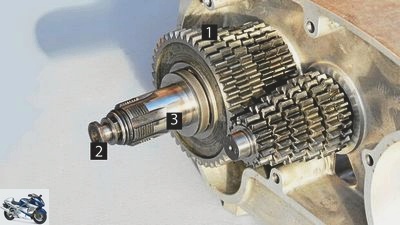Table of contents
- MOTOGP technology seamless gear of the Honda RC 213 V Full speed ahead
- Farewell to the conventional claw gear
- Properties of HRC precision mechanics
- Classic draw key gear

2snap
Sports & scene
Motorsport
Technology: Seamless transmission from the Honda RC 213 V.
MOTOGP technology seamless gear of the Honda RC 213 V
Full speed ahead
Content of
Honda drivers draw black lines, the competition has nothing to laugh about. Even if the mysterious seamless transmission only brings a few hundredths of a second per lap, it is precisely the fractions of a second that separate the winner from the runner-up. PS reveals the secret of the clever Honda construction.
Werner Koch
11/19/2013
As soon as the transmission is dismantled on a MotoGP factory Honda, there is a spirit of optimism. Race mechanics, tire technicians and chassis experts all have to leave the pits. Only a select group of HRC engineers are allowed to look into the control box of the RC 213V. And this despite the fact that Honda published the patent specification including drawings for the seamless transmission on February 3, 2011. But you can be sure that HRC only released the purely mechanical basics for inspection. The subtleties and the associated electronic engine control, however, are better guarded than the gold treasures in Fort Knox.
Buy complete article

MOTOGP technology seamless transmission of the Honda RC 213 V
Full speed ahead
5 pages) as PDF
€ 2.00
Buy now
The mechanical processes of the new switch box are so complex that we were only able to make them understandable using the drawings and functional sketches on pages 78/79. Even if many racing experts refer to the Honda construction with a smile on the old draw-wedge gears from Zundapp, Sachs and Maico in the 60s and 70s (see photos on page 80), if you look closely, there is little in common between the coarse moped gearboxes and discover the fine mechanical Honda work of art.
Farewell to the conventional claw gear
In order to understand why Honda – and, under pressure, Yamaha and Ducati – have said goodbye to the conventional claw transmission, you have to analyze the delicate shift phases on a demanding GP circuit very carefully and in slow motion. After the brutal braking, also this process is soothed with a lot of electronic magic, keyword increase in idle gas to adjust the engine drag torque, the daredevils clap their beasts in inclines of up to 65 degrees. The elbows paddle across the asphalt and you have the feeling that the guys just fall in a controlled manner in this phase, only to suddenly straighten the bike up a few seconds later to get as much grip as possible from the rear tire on the largest possible contact area.
Now the phase has been reached in which you gain a lot of time – or leave it alone. The seamless transmission, or SG for short, plays a decisive role here because maximum acceleration is possible at the exit of a curve in inclined positions from 40 degrees without the motorcycle swerving sideways. If a gear change is due, the motorcycle with a conventional gearbox and a correspondingly long interruption of the tractive power on the rear wheel will lose its footing, because even with an automatic gearshift it is around 0.1 seconds. With conventional gear changes with the clutch pulled, it takes around 0.3 seconds for the full engine power to pull back on the rear wheel.
This load change jolt can rock the motorcycle, hail the line or cross the load due to a too brutal torque peak. In addition, when the pulling force is interrupted, the rocker deflects a few centimeters and abruptly rebounds again after the switching process. Why? Because MotoGP machines, like all good super sports machines, are designed in such a way that the rear rebounds more or less strongly when you accelerate. This so-called anti-squad effect is achieved by a very steep rocker arm and a matching drive geometry (position and diameter of chain pinion and chain wheel) (see page 46/47 Technology). This effect has a positive influence on the frame and steering geometry of the machine at the exit of a curve.
The load change jolt during the conventional shifting process naturally also causes a short-term reduction in the contact pressure of the rear tire – keyword dynamic wheel load shifting – and thus allows the fork to bend slightly. The sum of these movements and changes in geometry makes the motorcycle restless and disrupts smooth, optimal acceleration. To make the differences between a conventional gearshift and the seamless transmission understandable, we have created a fictitious diagram based on real 2D data recording that illustrates the overlapping movements and changes. These unrest not only cost time, but also unnecessarily grind the tires together with the nerves of the pilot. The Honda designers no longer found pleasure in such capers and came up with the seamless shifting process in which two gears are actually engaged at the same time.
Properties of HRC precision mechanics
The complex HRC precision mechanics delight the Honda pilots with a whole range of advantages. On the one hand, you can casually upshift one or even two gears in tricky combinations of corners, which lowers fuel consumption and makes the motorcycle more drivable thanks to the less aggressive engine power. When fully accelerating in an inclined position, the slip and thus the slight drift angle remain constant and predictable. Thanks to these positive characteristics, the Honda factory drivers can steer at the exit of a curve, even if the front wheel loses contact with the ground during a power wheelie.
However, the motorcycle only stays in lane with a perfect drift angle if the rider gives the bike a twist towards the inside of the curve through acrobatic hanging-off and the resulting asymmetrical shift of the center of gravity. In addition, the MotoGP riders with an upper body placed as low as possible – especially Marc Marquez – also counteract the wheelie tendency when accelerating from a lean angle. Because this reduces the center of gravity, the front wheel remains on the ground. For the chassis technician, the seamless transmission offers more options for tuning, as the problem of a wildly swaying rear section is as good as eliminated by the smooth, even power output.
Of course, the HRC technicians also help with the electronic throttle grip. With the shifting process, which only takes around 10 milliseconds (i.e. 0.01 seconds), the engine output is adjusted so that the driver has the same tractive power on the rear wheel after the gear change and the resulting reduced engine speed as before. This adjustment takes place via a stored program in the engine control, which brings the throttle valve into the appropriate position so that traction and slip remain almost identical and the motorcycle can be accelerated further. An advantage that has put the competition in dire straits and has forced them to act.
Classic draw key gear
The comparison with the old moped transmissions only applies to the rough construction principle, in which the switching mechanism is housed in the hollow output shaft. On the Maico, the idler gears were connected to the shaft via a cross-shaped draw key (small photo above). Other manufacturers used a conical draw key to push balls through the drilled shaft, which then slide into the internal recesses of the gear wheels.
In contrast to the claw gear, in which the gears are shifted on the shaft (see PS 11/13), the Honda gear is similarly narrow as the Maico component shown. There, too, the six gear wheels are very close together. With the advantage that the short, hollow-drilled shaft has to withstand less deflection. Similar to a draw key, the Honda’s ratchets are operated from the inside. However, according to the regulations, this process may not be controlled electronically, hydraulically or pneumatically, but must be actuated by the driver via a mechanism.

Koch, Werner
The structure is the same as the old Maico RS 125 gearbox from the 1970s that of the Honda RC 213 V. Here, too, all six idler gears (1) and the internal gearshift mechanism (2) are housed on the output shaft (3).
The comparison with the old moped transmissions only applies to the rough construction principle, in which the switching mechanism is housed in the hollow output shaft. On the Maico, the idler gears were connected to the shaft via a cross-shaped draw key (small photo above). Other manufacturers used a conical draw key to push balls through the drilled shaft, which then slide into the internal recesses of the gear wheels. In contrast to the claw gear, in which the gears on the shaft ver-
be pushed (see PS 11/13), the Honda transmission is similarly narrow as the Maico component shown. There, too, the six gear wheels are very close together. With the advantage that the short, hollow shaft has to withstand less deflection. Similar to a draw key, the Honda’s ratchets are operated from the inside. However, according to the regulations, this process may not be controlled electronically, hydraulically or pneumatically, but must be actuated by the driver via a mechanism.
Related articles
-
Transmission technology in racing
2snap 22nd pictures Gargolov 1/22 With the motorcycles of the early years with their fuel shift levers, a gear change took what felt like an eternity….
-
Ducati patent: Seamless transmission from MotoGP
Ducati. 6th pictures Ducati 1/6 The seamless gears from MotoGP are known. For a good 10 years now, the drivers have been shifting load changes here….
-
motorcycles Enduro Technology Honda CRF 450 R Technology Honda CRF 450 R For the sake of simplicity Why complicated when it can be made easy? This is…
-
Comparison test: Honda Hornet, Kawasaki Z 750, Suzuki GSR 600
Jahn motorcycles Comparison test: Honda Hornet, Kawasaki Z 750, Suzuki GSR 600 Comparison test: Honda Hornet, Kawasaki Z 750, Suzuki GSR 600 ABS shooters…
-
Bilski motorcycles Naked bike Top test Honda Hornet 600 Top test Honda Hornet 600 Salute Europe’s top seller 2002. Unfortunately only 25th in Germany. So…
-
counselor Used purchase Used advice Honda CB 500 Used advice Honda CB 500 From the same mould Honda’s new model in the inexpensive entry-level class had…
-
New models: Honda CB 1100 2013
Honda motorcycles New models: Honda CB 1100 2013 New models: Honda Honda CB 1100 2013 Since the presentation of the CB 1100 design study at the Tokyo…
-
On the move: BMW R 75-5, Honda CB 750
wolf motorcycles On the move: BMW R 75/5, Honda CB 750 On the move: BMW R 75/5, Honda CB 750 The summer of 69 Content of Bryan Adams musically summed up…
-
Honda counselor Used purchase Used advice Honda CBF 500 Used advice Honda CBF 500 More than a driving school bike In the ranking of the most…
-
fact motorcycles Comparison test: Honda CBR 600 RR, Kawasaki ZX-6R, Suzuki GSX-R 600, Triumph Daytona 675, Yamaha YZF-R6 Comparison test: Honda CBR 600…